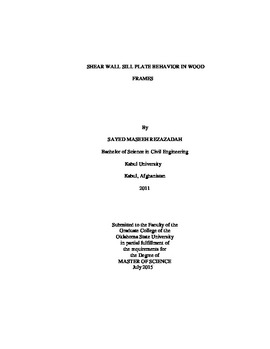| dc.contributor.advisor | Emerson, Robert N. | |
| dc.contributor.author | Rezazadah, Sayed Maseeh Maseeh | |
| dc.date.accessioned | 2016-09-29T18:42:41Z | |
| dc.date.available | 2016-09-29T18:42:41Z | |
| dc.date.issued | 2015-07-01 | |
| dc.identifier.uri | https://hdl.handle.net/11244/45307 | |
| dc.description.abstract | In the Midwest region of United States of America tornados are considered to be the most brutal form of natural disaster for the building houses where many of these houses are built out of wood. Newcastle-Moore tornado that happened in 2013 severely damaged a high number of houses in its path. Damage to a single component of a structure can cause the whole building to collapse. Failure of garage doors lets the wind enter the building and changes building envelope to a partially enclosed building where walls are subjected to uplift force that eventually cause the wall or sill plate to fail in connections. Additionally, the overturning moment in partially anchored shear walls put uplift forces on the bottom chord. In this report, a summary review have been done to determine the failure causes for damaged houses that were observed by post tornado assessment team in Moore 2013. A further in-depth study of sill plate behavior in wood frames is a core focus of this report. Sill plate failure mode found throughout this and previous studies describes most of the actual failures that happened on the site during the Moore, 2013 tornado. The sill plate failure modes can be described in three distinct scenarios. 1) Failing along bottom face due to bending moment from the sheathing to the connection 2) failure along the edge that is due to high tensile stress perpendicular to grains. 3) Failure of connections that can be between anchor bolts and foundation or sheathing to sill plate nailing. All these modes were tested in the lab, and the outcome results give the idea that a few critical factors in construction can significantly change failure modes. These factors are noticed in washer size, pith orientation, nailing spacing, bolt distance from sheathing and presence of a layer of the metal plate beneath the sill plate. The larger washer size or close bolt position reduces the moment arm and changes the failure from bending on the bottom face to failure along the edge. Pith orientation significantly affects the bending capacity of the sill plate. Metal plate at the bottom face of sill plate prevent the failure in bending and enhances the overall capacity. Four test configurations observed and analyzed in this study. Each pair consists of the plate with and without a metal connector. The first pair was in ideal condition while the two other was applied maximum possible bending stresses. It was determined that overall capacity is higher when bolts are at the center of the plate and metal plates at the bottom. This enhancement can give up to 30% more strength to the sill plate. However, in maximum bending stress metal plate acted more efficiently and increased the capacity by 60% more, but the overall applied loads were less than those with bolts at center. Conclusion and recommendation in this report are to place bolts at center, and metal plate connector on the bottom face to get the maximum capacity out of sill plate. | |
| dc.format | application/pdf | |
| dc.language | en_US | |
| dc.rights | Copyright is held by the author who has granted the Oklahoma State University Library the non-exclusive right to share this material in its institutional repository. Contact Digital Library Services at lib-dls@okstate.edu or 405-744-9161 for the permission policy on the use, reproduction or distribution of this material. | |
| dc.title | Shear Wall Sill Plate Behavior in Wood Frames | |
| dc.type | text | |
| dc.contributor.committeeMember | Ley, Tyler | |
| dc.contributor.committeeMember | Lewis, Michael Phil | |
| osu.filename | Rezazadah_okstate_0664M_14240.pdf | |
| osu.accesstype | Open Access | |
| dc.description.department | Civil Engineering | |
| dc.type.genre | Thesis | |
